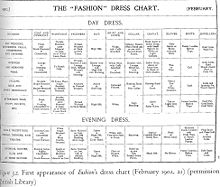Western dress codes
This article needs additional citations for verification. (May 2011) |
| Part of a series on |
| Western dress codes and corresponding attires |
|---|
|
Legend:
|
Western dress codes are dress codes in Western culture about what clothes are worn for what occasion. Classifications are divided into formal wear (full dress), semi-formal wear (half dress), and informal wear (undress). Anything below this level is referred to as casual wear, although sometimes in combinations such as "smart casual" or "business casual" in order to indicate higher expectation than none at all.
For both men and women, hats corresponding to the various levels of formality declined following the counterculture of the 1960s. As supplements to the standard dress codes headgear (see biretta, kippah etc.) can be worn. Ceremonial dress, military uniform, religious clothing, academic dress, and folk costume appropriate to the formality level are permitted alongside the respective dresscodesas alternatives. Conversely, since most cultures have at least intuitively applied some level equivalent to the more formal ones in Western dress code traditions, the latter's versatile framework open to amalgamation of international and local customs, have influenced its competitiveness as international standard formality scale.
| Formality | Men | Women | Military | Supplementary | ||
|---|---|---|---|---|---|---|
| Day | Evening | |||||
| Formal wear i.e. "Full dress" | Morning dress | White tie | Trouser suit or skirt with blazer if preferred | Ball gown | Full dress uniform | Ceremonial dress, religious clothing, folk costumes, orders and medals, etc. |
| Semi-formal wear i.e. "Half dress" | Black lounge suit | Black tie | Evening gown | Mess dress uniform | ||
| Informal wear i.e. "Undress" | Suit | Cocktail dress | Service dress uniform | |||
| Casual wear | Anything considered inappropriate for more formal occasions | |||||
Etiquette[]
Formal wear[]
Typical events: Weddings, state dinners and affairs, formal balls, royal events, etc.
Semi-formal wear[]
Typical events: Theatre opening nights, charity balls, etc. There is some variation in style depending on whether it is summer or winter. See black tie and stroller for more details.
Informal wear[]
Typical events: Diplomatic and business meetings, many social occasions, everyday wear
Casual wear[]
Casual wear encompasses business casual, smart casual, etc.
History[]


The background of traditional contemporary Western dress codes as fixed in 20th century relied on several steps of replacement of preexisting formal wear, while in turn increasing the formality levels of the previously less formal alternatives. Thus was the case with the ceasing of the justacorps, extensively worn from the 1660s until the 1790s, followed by the same fate of the 18th century frock (not to be confused with frock coat), in turn followed by the frock coat.
Full dress, half dress, and undress[]
Formal, semi-formal, and informal all have roots in 19th century customs subsequent to the replacement of the 18th century generic justaucorps, and has remained fixed defined since the 20th century. The 19th century frock coat rarely occurs except as formal alternative. For women, interpretations have fluctuated more dynamically according to fashion.
Before the modern system of formal, semi-formal, and informal was consolidated in the 20th century, the terms were looser. In the 19th century, during the Victorian and Edwardian periods, the principal classifications of clothing were full dress and undress, and, less commonly the intermediate half dress. Full dress covered the most formal option: frock coat for day wear, and dress coat (white tie) for evening wear (sometimes with supplementary alternative being a full dress uniform independent of what time of the day). As such, full dress may still appear in use designating formal wear.
When morning dress became common (in the modern sense, using a morning tailcoat rather than a frock coat), it was considered less formal than a frock coat, and even when the frock coat was increasingly phased out, morning dress never achieved full dress status.[citation needed] Therefore, in the 21st century, full dress often refers to white tie only.[citation needed]
Today's semi-formal evening black tie (originally dinner clothes) was initially described as informal wear, while the "lounge suit," now standard business wear, was originally considered (as its name suggests) casual wear. Half dress, when used, was variously applied at different times, but was used to cover modern morning dress (the term morning dress is fairly undescriptive and has not always meant modern morning dress). Undress (not to be confused with naked) in turn was similarly loose in meaning, corresponding to anything from a dressing gown to a lounge suit or its evening equivalent of dinner clothes (now one of the more formal dress codes seen in many Western regions).[1]
References[]
- ^ Kent State University Museum (2002). "Of Men & Their Elegance". Archived from the original on 2008-10-17. Retrieved 2008-11-02.
Further reading[]
- Sondag, Glen (2011). Anything Other Than Naked. London Street Press. pp. 200 pages. ISBN 978-1-936183-83-8.
- Formal wear
- Western culture
- Dress codes


